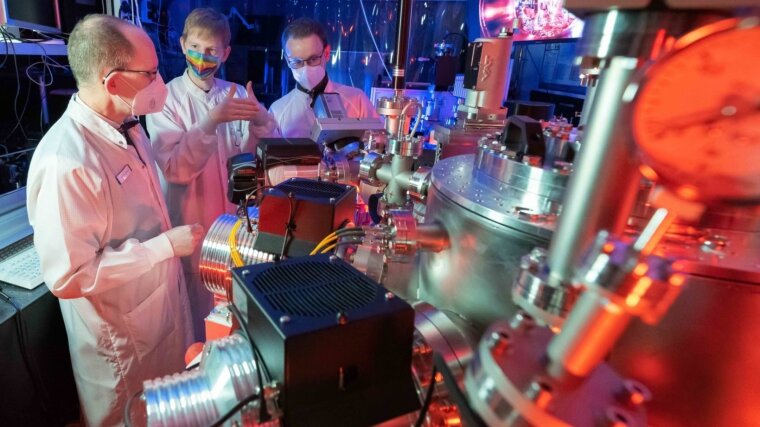
Although XUV light can be used to image nanoscale structures, generating coherent light with a wavelength of only a few tens of nanometres has so far only been achieved in major research facilities. A team of researchers at the University of Jena are using nonlinear optical effects to generate such radiation – at a conventional laser laboratory – to non-destructively determine the inner structure of materials and their chemical composition with nanoscale precision.
By Ute Schönfelder
Images provide insights. What we can observe with our own eyes enables us to understand. Constantly expanding the field of perception into dimensions that are initially hidden from the naked eye, drives science forward. Today, increasingly powerful microscopes let us see into the cells and tissues of living organisms, into the world of microorganisms as well as into inanimate nature. But even the best microscopes have their limits. »To be able to observe structures and processes down to the nanoscale level and below, we need new methods and technologies,« says Dr Silvio Fuchs from the Institute of Optics and Quantum Electronics at the University of Jena. This applies in particular to technological areas such as materials research or data processing. »These days, electronic components, computer chips or circuits are becoming increasingly small,« adds Fuchs. Together with colleagues, he has now developed a method that makes it possible to display and study such tiny, complex structures and even ›see inside‹ them without destroying them.
The researchers recently presented their method—coherence tomography with extreme ultraviolet light (XCT)—in ›Optica‹, where they demonstrated its potential applications in research and other areas.
Light penetrates the sample and is reflected by internal structures
The imaging procedure is based on optical coherence tomography (OCT), which has been established in ophthalmology for a number of years, explains doctoral candidate Felix Wiesner, the lead author of the study. »These devices have been developed to examine the retina of the eye non-invasively, layer by layer, to create 3-dimensional images.« At the ophthalmologist, OCT uses infrared light to illuminate the retina. The radiation is selected in such a way that the tissue to be examined does not absorb it too strongly and it can be reflected by the inner structures. However, the physicists in Jena use extremely short-wave UV light instead of long-wave infrared light for their OCT. »This is due to the size of the structures we want to image,« says Felix Wiesner. In order to look into semiconductor materials with structure sizes of only a few nanometres, light with a wavelength of only a few nanometres is needed.
Coherent XUV light created by nonlinear optical effect
Generating such extremely short-wave UV light (XUV) used to be a challenge and was almost only possible in large-scale research facilities. Jena physicists, however, generate broadband XUV in an ordinary laboratory and use what are called high harmonics for this purpose (see box below). This is radiation that is produced by the interaction of laser light with a medium and it has a frequency many times that of the original light. The higher the harmonic order, the shorter the resulting wavelength. »In this way, we generate light with a wavelength of between 10 and 80 nanometres using infrared lasers,« explains Prof. Gerhard Paulus, Professor of Nonlinear Optics at the University of Jena. »Like the irradiated laser light, the resulting broadband XUV light is also coherent, which means that it has laser-like properties.«
In their experiments, the physicists exposed nanoscopic layer structures in silicon to the coherent XUV radiation and analysed the reflected light. The silicon samples contained thin layers of other metals, such as titanium or silver, at different depths. Because these materials have different reflective properties from the silicon, they can be detected in the reflected radiation. The method is so sensitive that not only can the deep structure of the tiny samples be displayed with nanometre accuracy, but—due to the differing reflective behaviour—the chemical composition of the samples can also be determined precisely and, above all, in a non-destructive manner. »That’s what makes coherence tomography an interesting application for inspecting semiconductors, solar cells or multilayer optical components,« says Paulus. It could be used for quality control in the manufacturing process of such nanomaterials, to detect internal defects or chemical impurities.
High harmonics
The term ›harmonic‹ is used in physics to refer to an oscillation whose frequency is an integer multiple of the fundamental frequency. In music, harmonics appear as overtones. However, harmonics can also be formed by light and other electromagnetic waves. In nonlinear optics, the term »high harmonics« is used to refer to light waves whose frequency is approximately 10 times that of the original laser frequency or greater.
In order to generate high harmonics, extremely intense laser light is required: Laser pulses with an intensity of 1014 W/cm2 (one hundred trillion watts per square centimetre) are concentrated on matter (diluted gas). The electrical field strength of these pulses is so great that they tear the electrons out of their shell. As the direction of the electrical field in a light wave switches back one trillion times a second, however, the electrons are accelerated back to their original atom just as often. This is where they give off their kinetic energy in the form of harmonic light waves.
Original-Publication:
Material-specific imaging of nanolayers using extreme ultraviolet coherence tomography, Optica (2021), DOI: 10.1364/ OPTICA.412036External link